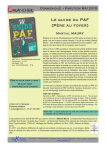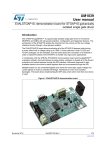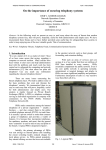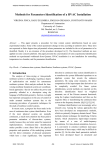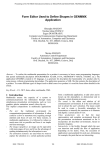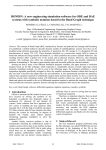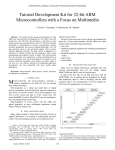Download as a PDF
Transcript
WSEAS TRANSACTIONS on ELECTRONICS Dalibor Biolek, Jaroslav Kadlec, Viera Biolková and Zdeněk Kolka Interactive Command Language for OrCAD PSpice via Simulation Manager and its Utilization for Special Simulations in Electrical Engineering DALIBOR BIOLEK1,2, JAROSLAV KADLEC2, VIERA BIOLKOVÁ3, ZDENĚK KOLKA3 1 Dept. of EE, University of Defense, Brno, Czech Republic 2 Dept. of Microelectronics, Brno University of Technology, Czech Republic 3 Dept. of Radio Electronics, Brno University of Technology, Czech Republic [email protected] http://user.unob.cz/biolek Abstract: The Interactive Command Language (ICL) significantly extends the simulation performance of several programs based on SPICE3 standard for the analysis of electrical networks in the so-called sequential mode, when the relatively independent tasks are run consecutively with a possibility of data exchange. However, the ICL is not implemented in the well-known OrCAD PSpice simulation program. The paper describes a conception of the so-called PSpice Simulation Manager (PSiM). This program implements the ICL in OrCad PSpice. PSiM is an independently executable program which controls the OrCad PSpice, enabling its operation in sequential mode. A powerful programming language also enables iterative runs within the conditional loops, which can be utilized e.g. for optimization. Concrete demonstrations of PSiM performance for circuit optimization and AC analysis of switched networks are included at the conclusion. Keywords: - PSpice, PSiM, simulation, analysis, circuit The PSpice Simulation Manager (PSiM), described in this paper, is designed to control the OrCAD PSpice in agreement with the user’s intentions [10]. The controlling algorithm is defined by the so-called Manager Control File (MCF). This file should be written according to the syntactic rules of special programming language of the manager. This language contains, among other things, the instructions for compiling the ECIR (Extended Circuit File), which is a source text for generating the PSpice Circuit File (PCIR), commands for defining the variables, for defining basic PSpice analyses which should be executed, for controlling the PSpice operation, and for receiving the simulation results, saving them in variables, and processing them mathematically. The paper is organized as follows: Section 2 next to this introductory part confronts the conventional conception of PSpice analysis with newly proposed method based on PSiM. As a result of this comparison, benefits and sense of the PSiM implementation are made clear. Section 3 presents the overall characteristics of the PSiM and its language. Some relevant details are given in Section 4. Next Sections illustrate concrete PSiM applications, particularly the analyses which cannot be performed within the conventional PSpice utilization. 1 Introduction Programs of the Spice or PSpice type are widely used for solving various problems in electrical engineering both at academic institutions and in industry [1-5]. OrCAD PSpice [6] is one of today’s well-known programs from this category. In contrast to WinSpice [7], ISSpice4, ICAP/4 [8] and other similar programs, it does not support the utilization of ICL (Interactive Command Language) [7-9] for controlling the simulation tasks. However, this language represents a powerful tool for operation in the so-called sequential mode, when the simulation tasks are run consecutively, with the ability to influence the character of consecutive operations, depending on the attained state of the simulation run. That is why the OrCAD PSpice users cannot solve problems of the following character: Successive automated runs of different types of analyses, e.g. AC, Transient, DC, immediately after the end of the foregoing analysis, utilizing data from this analysis for the current simulation run. The consecutive modifications of model parameters, which would depend on the results of previous analyses. Repeated run of various simulation tasks in the loops until the optimal behavior of circuit model is reached. ISSN: 1109-9445 186 Issue 5, Volume 5, May 2008 WSEAS TRANSACTIONS on ELECTRONICS Dalibor Biolek, Jaroslav Kadlec, Viera Biolková and Zdeněk Kolka automatically from the PSpice data files. That is why Probe is only used post facto for user’s manual processing of the analysis results. 2 Conventional PSpice versus PSiM conception The conventional conception of working with OrCad PSpice is illustrated in Fig. 1. Circuit File header netlist commands .end PSpice pspice.exe Circuit File header netlist commands .end results output file Probe files bias point file ......... PSpice psp_cmd.exe results output file Probe files bias point file ......... Probe schematic capture Probe PSiM user MCF header Fig. 1: Conventional conception of the interaction between the user and the OrCadPSpice. schematic capture The user can create the model of simulated circuit either directly by writing the PSpice circuit file or indirectly through the schematic capture. In the letter case, the corresponding circuit file is compiled automatically after running the analysis. Results of the analyses are available either via more kinds of data files or by means of graphical postprocessor Probe. In any case, the above discussed sequential mode of the analysis cannot be executed automatically but only due to user’s activity: user must analyze the results, and, based on this analysis, to modify manually the input data for a subsequent analysis. In the new conception, shown in Fig. 2, PSiM replaces the controlling role of user. The user controls the simulation process indirectly via the so-called Manager Control File (MCF) which can be written either directly or indirectly via a special schematic capture. The MCF can be considered as a generalization of PSpice circuit file. It contains instructions for controlling the PSiM. According to these instructions, PSiM generates the circuit file for PSpice, collects the analysis results, performs their post-processing, and controls automatically the subsequent analysis runs. Instead of the pspice.exe, only the computational core psp_cmd.exe is run which enjoys several advantages [6]. The PSpice circuit file is generated by PSiM directly without a necessity of using the OrCAD schematic capture. Also the information about the analysis results are extracted ISSN: 1109-9445 commands user Fig. 2: Proposed conception of the interaction between the user and the OrCadPSpice via PSiM. The detailed conception of the co-action of the PSiM and the computing PSpice core is illustrated in Fig. 3. Manager Control File (MCF) header ... set variable=1 ... assemblycir x.cir ... Rx 1 2 variable ... endassembly psp_cmd.exe run x.out x.cir data from PSpice analyses data from bias points ... ;re-defining the variables ... ... ;last command of MCF Extended Circuit File (ECIR) x.dat x.csd x.bias PSpice Circuit File (PCIR) Fig. 3: Simplified schematic of the communication between the PSiM and the simulation program via the Manager Control File. 187 Issue 5, Volume 5, May 2008 WSEAS TRANSACTIONS on ELECTRONICS Dalibor Biolek, Jaroslav Kadlec, Viera Biolková and Zdeněk Kolka program should therefore be able to work with variables representing real numbers and to evaluate arithmetic terms which can contain variables, numerical constants, basic operators (+, -, *, /, ^), braces, and some mathematical functions. In other words, some commands should be defined which enable the definition/declaration of variables and the evaluation of arithmetic terms. The commands from the MCF are executed step by step in a sequence that is defined in this file. The source text of ECIR for generating the PCIR for running an independent simulation task is bounded by a pair of the assemblycir and endassembly commands. In this text, the conventional PSpice syntax can be combined with the extended commands of the PSiM. At the moment of processing the endassembly command, the conventional PCIR is automatically generated, and the computational core psp_cmd.exe is subsequently run with the generated PCIR as a parameter. The manager is waiting until the end of simulation and then it finds out, on the basis of the return code, if the simulation ran correctly. In the case of an error, the operation of the manager is terminated. The user can identify this error from the output file generated. When the simulation run is terminated correctly, both the output file and – depending on the character of the simulation task – other files containing the results of individual analyses (Transient, AC, or DC) are available, as well as the calculated coordinates of the bias points. All these results can be read as new variables of the PSiM. For example, we define the VP variable and save the value of the voltage between the nodes p and 0 in time 10ms to this variable. This variable can be used for defining the PCIR of subsequently executed simulation. • The ECIRs (Extended Circuit Files) of the circuits being analyzed can appear in the MCF. Thus commands should exist for the definition of the beginning and the end of such an ECIR. The command defining the beginning should have a parameter indicating the file name. The given PCIR will then be generated into this file. The command defining the end of the ECIR will cause the PSpice to run with the name of the PCIR as a parameter. The PSiM will wait for the end of the simulation and then it will continue on the next line of the MCF. • The PCIR contents can be modified prior to its generation by the SiM. Recording the value of arithmetic term in a certain place of the PCIR is one of the alternatives. It should be possible to write in the text of the ECIR a command for evaluating the arithmetic term. At the moment when the PCIR is generated, this term is evaluated by the PSiM and its numerical value is written into the PCIR. This method can, for example, modify the parameters of some circuit components in order to perform optimization. 3 Characteristics of the simulation manager and its language • The PSiM should be able to process the results of already executed simulations. Thus some commands should be defined for reading such results. The results of certain simulations can be saved by PSpice in the text files. The PSiM should be able to process these files. The commands in the MCF will enable saving such values into user-defined variables. It will enable subsequent work with these values. The MCF (Manager Circuit File) serves as the input of the PSiM. This file contains models of simulated circuits in the PSpice language and special commands for controlling the simulation tasks for the PSiM. The commands for PSiM should be unambiguously distinguishable from the PSpice commands. The structure of the MCF should be clear and transparent. The MCF is thus a record of a program for the PSiM. It was necessary to design a new, simple programming language for the above control of simulation tasks. The requirements for this language were defined as follows: • After finishing the activities of the PSiM, all the files generated from all executed simulation runs should be available. They are all PCIRs and the corresponding output files, and the data files containing the results of the simulations which were generated by utilizing the .SAVEBIAS or .PROBE commands. The PSiM can perform the conservation of these files such that it will perform their backup under modified names after finishing the simulation run. The • The PSiM will read the MCF step-by-step, starting from the first line (the MCF is processed sequentially). • The programming language of the PSiM should support simple mathematical computations. The ISSN: 1109-9445 188 Issue 5, Volume 5, May 2008 WSEAS TRANSACTIONS on ELECTRONICS Dalibor Biolek, Jaroslav Kadlec, Viera Biolková and Zdeněk Kolka new file names will be derived from their original names via their extension by numbers corresponding to the order of the simulation run. found here, i.e. an incorrect notation of the PSiM commands or their incorrect location. The response to this error means terminating the MCF processing and displaying an error message. During the syntactic analysis, the text of the MCF is fragmented into individual syntactic elements (e.g. commands, comments, lines of the generated PCIR, etc.). The syntactic elements are represented by a data structure (class). A list of these elements or commands is created during the syntactic analysis. The second phase of the PSiM operation consists in performing the commands from this list. The PSiM activity is terminated if the end of this list is achieved or if a command for breaking or stopping is executed or in the case of error (e.g. division by zero, etc.). In the course of processing the MCF, the syntax correctness of generated PCIRs is not checked. This checking will be only done by PSpice itself when processing this PCIR. Then PSpice will simultaneously carry out the simulation. The result of syntactic checking or the occurrence of another error can be learned from the return code of the psp_cmd.exe program. When the return code is zero, the simulation was carried out without error. If not, some error appeared. A description of this error is given in the output file. If such an error occurs during the simulation, the PSiM is terminated. • The PSiM should include commands for program loops and chaining (the if and while commands, known from other programming languages) on the basis of boolean relations. By means of boolean relations it should be possible to compare the values of arithmetic terms, as well as to link the boolean expressions to more complicated units via logical operators (and, or, negation, etc.). • The commands for program loops and chaining should be also placed in the text for generating the PCIR. In this way, the user can control which parts of the PCIR will be generated or which parts will be repeated more times. • The goto command can also be included among the commands for program loops and chaining. It serves for passing the control to the given label (which is defined by the label command). This whole group is called “commands for run control”. Thanks to these commands, we can algorithmize the evaluation of the results of foregoing simulations and control other simulations. • A command should exist for including a file, analogous to the PSpice command .INC. The included file could also contain the commands of the PSiM, thus it would be a MCF. That is why the PSpice command .INC cannot be used for such cases. Using this method, the program controlling the PSiM could be divided into several files, making its structure more transparent. We can also reuse the already generated parts of the program by this approach. 4 PSiM variables, operators, and commands • The possibility of writing the comments belongs to the natural demands on the PSiM language. A reasonable choice is to assume the same format as in PSpice: if the first character on the line is *, then the content of the line means a comment. When the comments are written in the ECIR which generates the PCIR, they will be also written into this PCIR. For storing the data and its mathematical processing, user can define PSiM variables of several types, namely scalars, vectors, and twoand three-dimensional matrices. New variables can be defined and evaluated on the basis of the existing variables via operators, functions, and commands. In addition to a common mathematical operators and functions, known from high-level languages, some vector and matrix operators and functions are also implemented here which are inspired by Matlab features. In this Section, several basic PSiM commands are summarized. All of them can be sorted to the following categories. Description of their syntax is out of the scope of this paper. The PSiM works as an interpreter of the above language. The PSiM operation can be divided into two phases. The syntactic analysis of the MCF is performed in the first step. Syntactic errors can be • Commands for defining the variables and their values: set defining scalar variable array defining vector or matrix variable ISSN: 1109-9445 189 Issue 5, Volume 5, May 2008 WSEAS TRANSACTIONS on ELECTRONICS Dalibor Biolek, Jaroslav Kadlec, Viera Biolková and Zdeněk Kolka • Commands for working with PSiM subcircuits: beginnet beginning the PSiM netlist endnet ending the PSim netlist use calling the PSiM netlist genTpoint generating values of specified circuit variables for concrete time instant getTpoint reading the above variables to PSiM variables genFpoint generating values of specified circuit variables for concrete frequency getFpoint reading the above variables to PSiM variables • Command for including source files of MCF: include includes arbitrary source file to the MCF • Commands for generating the PSpice circuit files: assemblycir beginning the circuit file endassembly ending the circuit file The following Section provides an introductory illustration of how to use the PSiM features for simple optimization of transistor amplifier. • Commands for generating the cycles and Boolean conditions: if..elsif..else..endif while..endwhile for..endfor break continue label goto halt 5 Demonstration 1 – circuit optimization A simple schematic of transistor circuit is shown in Fig. 4. Rb1 is requested to design in order to set collector DC voltage to 8V. bat Vbat Rb1 ? • Commands for interpreting conventional PSpice commands: beginspice beginning PSpice code endspice ending PSpice code 12V c b Rb2 Q1 33k • Commands for defining and running basic DC, AC, and Transient analyses: defsim defining the analysis runsim running the analysis 0 0 2N2222 e Re 200 0 • Commands for generating and reading the coordinates of DC operating point: genbias generating the DC operating point getbias reading it to a vector variable Fig. 4: Example of the optimized circuit. This task can be solved numerically via the method of interval bisection as schematically shown below: • Commands for generating and reading the data files for Probe post-processor: genprobe generating Probe data for a concrete analysis getprobe reading Probe data to vector variables Rmin=10k, Rmax=500k, error=1m, Vreq=8V Rb1 = (Rmin+Rmax)/2 Analysis of Vcollector abs((Vcollector-Vreq)/Vreq)>error: • Commands for running the so-called singlepoint DC, AC, and Transient analyses and for reading their results: genQpoint generating DC values of specified circuit variables geTQpoint reading the above variables to PSiM variables ISSN: 1109-9445 Rc 1.9k Vcollector>Vreq: yes no yes no Rmax = Rb1 Rmin = Rb1 end 190 Issue 5, Volume 5, May 2008 WSEAS TRANSACTIONS on ELECTRONICS Dalibor Biolek, Jaroslav Kadlec, Viera Biolková and Zdeněk Kolka First of all, the minimum and maximum values Rmin and Rmax of RB1 are defined together with the required value of collector voltage and the acceptable error of setting this voltage. Then the Rb1 is computed as average value of Rmin and Rmax. For this Rb1, the bias point computation in PSpice is performed and actual value of collector voltage is obtained. If the relative error is acceptable, the process of searching Rb1 is finished. Otherwise, the actual value of Rb1 will replace the value Rmin or Rmax, depending on the fact if the collector voltage is smaller or larger than the required value, and the analysis is performed again with Rb1 as average value of Rmin and Rmax. The corresponding Manager Control File (MCF) is listed below. For lucidity, the individual lines are numbered. Note that these numbers are not part of the MCF. 1: 2: 3: 4: 5: 6: 7: 8: 9: 10: 11: 12: 12: 13: 14: 15: 16: 17: 18: 19: 20: 21: 22: 23: 24: 25: The couple of commands beginnet and endnet on lines No. 5 and 12 enclose the Manager subcircuit named ampli, which defines the PSpice netlist of the circuit with one exception on line No. 10, where the formula #$Rb1$ is used for the definition of resistance Rb1. The # symbol means that the interpretation of this formula will be provided by the PSiM, not PSpice. Then the pair characters $ $ follow, between them is the formula. The numerical value of this formula is included into the generated PCIR by the PSiM. In this case, the formula is very simple because it contains only the Rb1 variable. The definition of the ECIR follows (the assemblycir command on line 13 with the pair command endassembly on line 16). The PCIR is generated according to this definition. It will include the text of ampli subcircuit (due to the use ampli command) as well as a source text of a special single-point analysis, defined on line No. 15. This command forces PSpice to perform single-point DC analysis with subsequent generating DC value of the quantity, defined within the curly braces (here v(c)), into the PSpice output file. The command on line No. 17 reads this value into the variable Vact, i.e. actual collector voltage. The following commands on lines 18 to 25 contain the above discussed cycles and Boolean conditions. The analysis runs 10 times. The resulting value of Rb1 is 241.3kOhms. The corresponding value of collector voltage is 7.997 volts. The above introductory demonstration is rather simple, serving for acquainting with PSiM basic features. It is true that the optimal value of Rb1 can be easily determined via convential PSpice analyses, e.g. via stepping Rb1 within the DC analysis. The main advantages of PSiM consist in simulation tasks where more consecutive analyses with data sharing are required. The following demonstration shows such solution which cannot be performed via the conventional PSpice utilization. *transistor circuit set Rmin=10k Rmax=500k Vreq=8 err=1m label START set Rb1=0.5*(Rmin+Rmax) beginnet ampli Vbat bat 0 12V Q c b e Q2N2222 Rc bat c 1.9k Re e 0 200 Rb1 bat b #$Rb1$ Rb2 b 0 33k .lib endnet assemblycir run use ampli genQpoint Qdc {v(c)} endassembly getQpoint Qdc Vact 1 while abs((Vact-Vreq)/Vreq)<=err if Vact>Vreq Rmin=Rb1 else Rmax=Rb1 endif goto START endwhile 6 Demonstration 2 - AC analysis of circuits with periodically controlled switches The first line represents a conventional header of the circuit file according to common PSpice conventions. The definitions of variables Rmin, Rmax, Vreq and err are placed on line No. 2. The line No. 3 is labeled as START. Line No. 4 includes a command for computing Rb1 as average value of Rmin and Rmax. ISSN: 1109-9445 A direct small-signal AC analysis of switchedcapacitor (SC), switched-current (SI) and other circuits with periodically controlled analog switches belong to well-known limitations of Spice-compatible programs. 191 Issue 5, Volume 5, May 2008 WSEAS TRANSACTIONS on ELECTRONICS Dalibor Biolek, Jaroslav Kadlec, Viera Biolková and Zdeněk Kolka on the frequency response can be neglected, which substantially simplifies the subsequent computer analysis. This neglecting is implemented by introducing the assumption that the input signal vin is of the Sample-Hold (SH) character [15], e.g. with discontinuities at switching instants. The consistence of initial conditions and the continuity of state variables should be ensured while modeling the input gate of the switched circuit. Under the above assumptions, the switched circuit can be described in each switching phase by linear equations (1) and (2): A method of direct AC analysis of idealized two-phase SC filters in PSpice has been described in [11]. The frequency responses are acquired neither via the repeated TRANSIENT analysis nor by the method of multi-tone excitation [12], but through a direct application of the conventional AC analysis to a special model of switched circuit. AC analysis of general linear switched circuits while taking into consideration influences of real phenomena, e.g. nonzero switch on-resistances, parasitic inductances, frequency dependent OpAmp gains, etc., is hardly applicable in Spicecompatible programs. The method described in [11] is based on the assumption of immediate changes of capacitor voltages at the switching instants. That is why it cannot be used for such cases when the lengths of transient phenomena caused by switching processes cannot be neglected. The new method presented below can be used only on the assumption that the PSpice features will be extended by the utilization of PSiM. Consider a linear switched circuit with twophase switching, i.e. a circuit that can be modeled by a pair of linear circuits, separately for switching phases 1 and 2. Let the lengths of switching phases 1 and 2 be denoted T1 and T2, respectively. Their sum is equal to the switching period T=1/Fs, where Fs is the switching frequency. Exclusion of the so-called inconsistent initial conditions (IIC) [14] is a basic assumption of PSpice simulation of real switched circuits. The IIC can arise in the case of idealized modeling, e.g. when two capacitors with different initial voltages are connected in parallel by an ideal switch with zero on-resistance. Accepting this assumption is a necessary consequence of the fact that the internal algorithms of PSpice cannot resolve numerical problems which are associated with the IIC. One can easily avoid the IIC, e.g. by defining nonzero on-resistances of all the switches inside the circuit. Let us define state variables within each switching phase of the circuit such that they are continuous in time at instants between the switching phases. Let the vectors of such state variables for phases 1 and 2 be denoted x1 and x2, respectively. In the case of avoiding the IIC, the vectors of state variables can be compounded of capacitor voltages and inductor currents. As shown in [15], the behavior of real switched networks is also affected by variations of the input signals within the relatively short switching phases. However, when the real phenomena are not extremely significant, then such an influence ISSN: 1109-9445 End of switching phase No. 1 at time t = kT+T1, k =..0, 1, 2.. x 1 ( kT + T1 ) = A 1 x 2 ( kT ) + B 1v in ( kT + T1 ) . (1) End of switching phase No. 1 at time t = kT+T, k =..0, 1, 2.. x 2 ( kT + T ) = A 2 x1 ( kT + T1 ) + B 2 vin ( kT + T ) , (2) where A1, A2, B1, and B2 are the matrices/vectors whose elements depend on the character of transient phenomena in the circuit within the corresponding switching phases. Utilizing the theory of generalized transfer functions [15], equations (1) and (2) can be converted to the z-domain: X1 = A1X 2 z −T1 / T + B1Vin,1 , (3) X 2 = A 2 X1 z −T2 / T + B 2Vin,2 , (4) where X1, X2, Vin,1, and Vin,2 are the z-transforms of signals x1, x2, vin, sampled at time instants in which the switching phases 1 or 2 are terminated. We can conclude that the AC analysis of the switched circuit should be accomplished in the following consecutive steps: 1) Computing the elements of matrices and vectors A1, A2, B1 a B2. 2) AC analysis of equations (3) and (4), utilizing the well-known substitution z = exp(jωT). A possible method of computing the B1 vector implies from Eq. (1): The conventional TRANSIENT analysis is executed during switching phase No. 1 on the assumption of vin = 1V and under zero initial condition x2(kT). Then the vector x1 at the end of this analysis will contain the elements of vector B1. 192 Issue 5, Volume 5, May 2008 WSEAS TRANSACTIONS on ELECTRONICS Dalibor Biolek, Jaroslav Kadlec, Viera Biolková and Zdeněk Kolka at the ends of switching phases 1 and 2, respectively [15]. The frequency responses for the selection of output samples in phase 1 or 2, computed in AC analysis, are defined by the frequency dependence of the magnitude ratios and the differences of initial phases of the corresponding equivalent signal and the input signal. We select the only state variable in the circuit, i.e. the capacitor voltage v. The matrices and vectors of A and B types in equations (1)-(4) are then reduced to scalars a1, a2, b1, and b2. Since the switch in Fig. 5 separates the entire circuit from the input signal during phase 2, the relation b2 = 0 holds and thus there is no need to compute this quantity. A list of the MCF is given below. When the TRANSIENT analysis of circuit in phase 1 is performed under the condition of vin = 0 and with state variable No. i being set to one, then the vector x1 at the end of this analysis will contain the elements of column No. i of matrix A1. An analogous procedure can be repeated for phase No. 2 in order to compute vector B2 and matrix A2. After computing the above vectors and matrices, item 2) will be performed via behavioral modeling of equations (3) and (4) and the following AC analysis. The sequence of PSpice simulation tasks can be described as follows: For k=1..2 *computing the Bk vector Φ Modeling the circuit within phase No. k, vin=1V, zero initial conditions. TRANSIENT analysis till the time Tk. Reading the values of state variables and saving them to the Bk vector. vin(t) R C v(t) *computing the Ak matrix Modeling the circuit within phase No. k, vin=0V, zero initial conditions. For i=1..N ; vin(t) v(t) v 1e (t ) N is the number of state variables t Setting state variable No. i to one. v TRANSIENT analysis till the time Tk. Φ Reading the values of state variables and saving them to the ith column of Ak matrix. 1 2 1 2 1 2 1 2 2e (t ) 1 2 1 2 t kT end kT+T kT+T1 end Fig. 5: Model of SH circuit and a demonstration of circuit waveforms. It should be noted that PSpice cannot provide the above algorithm independently, without the user’s interventions. That is why a cooperation between PSpice and PSiM is required. PSiM should provide an automated run of the analyses according to the above algorithm. As a demonstration of the above approach, a simple model of the Sample-Hold circuit is shown in Fig. 5 together with the waveforms of input and output voltages and switching impulses. Also the so-called equivalent signals v1e and v2e are indicated here. They represent the continuous-time equivalents of discrete-time signals at time instants ISSN: 1109-9445 1: 2: 3: 4: 5: 6: 7: 8: 9: 10: 11: 193 *AC analysis of Sample-Hold circuit set Ron 5k fs 100k T1 0.1/fs T2 1/fs-T1 beginnet SH1 Ron 1 2 #$Ron$ Rs 2 3 10m C 3 0 1n Rz 2 0 100k endnet beginnet SH2 Rs 2 3 10m C 3 0 1n Issue 5, Volume 5, May 2008 WSEAS TRANSACTIONS on ELECTRONICS Dalibor Biolek, Jaroslav Kadlec, Viera Biolková and Zdeněk Kolka circuit file is created, the simulator is run automatically and the corresponding analysis is performed. The value of output voltage at time T1, i.e. at the end of the analysis, is saved to variable b (see line 22). This variable is labeled as b1 in equations 1 and 3. The other circuit file RUN2.CIR is defined on lines 23 to 28 for computing the variable a1 (A1 matrix reduced to a scalar). Here the input voltage is zero and the natural response to the initial condition of state variable V = 1V is computed. Accordingly, the analysis of circuit file RUN3 within switching phase 2 leads to variable a2. Equations (3) and (4) are modeled on lines 36 to 42 by means of E-type controlled sources. This model is then analyzed via the AC analysis. 12: Rz 2 0 100k 13: endnet 14: defsim tran1 .TRAN 0 #$T1$ 0 #$T1/100$ + skipbp 15: defsim tran2 .TRAN 0 #$T2$ 0 #$T2/100$ + skipbp 16: defsim AC .AC dec 100 10 #$fs*2$ 17: assemblycir run1.cir 18: Vin 1 0 1V 19: use SH1 20: runsim tran1 21: endassembly 22: getprobe b tran1 V(3) #$T1$ 23: assemblycir run2.cir 24: Vin 1 0 0V 25: use SH1 26: .IC V(3) 1V 27: runsim tran1 28: endassembly 29: getprobe a1 tran1 V(3) #$T1$ 30: assemblycir run3.cir 31: use SH2 32: .IC V(3) 1V 33: runsim tran2 34: endassembly 35: getprobe a2 tran2 V(3) #$T2$ 36: assemblycir run4.cir 37: Vin 1 0 AC 1 38: Ec1 c1 x +LAPLACE {V(c2)} {#$a1$*exp(-s*#$T1$)} 39: Ex x 0 value={V(1)*#$b$} 40: Ec2 c2 0 +LAPLACE {V(c1)} {#$a2$*exp(-s*#$T2$)} 41: runsim AC/nocsdf 42: endassembly 0 -10 -20 10Hz 100Hz 10KHz DB(V(c1)) DB(V(c2)) Frequency Fig. 6: Results of PSpice AC analysis: Amplitude frequency response with output samples at phases 1 (V(c1)) and 2 (V(c2)). The entire sequence of the simulation runs takes fractions of a second on AMD Athlon™ 64 3500+ 2.21GHz, 2GB RAM with installed OrCAD PSpice ver. 16. The resulting frequency responses in Fig. 6 are equivalent to results obtained from a special SPIN program [15]. The MCF starts by a header (line No. 1). The definition of variables via set command is on line 2. The subcircuits SH1 (SH2), defined within the lines 3 and 8 (9 and 13), model the SH circuit as two linear circuits at phases 1 and 2. Three types of analyses are defined on lines 14 to 16. They will be used later in the frame of automatically generated PSpice input files: the TRANSIENT analysis within switching phase 1 or 2 (line 14 or 15), and the AC analysis within the frequency range from 10Hz to the double of switching frequency, i.e. to 200kHz (line 16). The commands for the generation of PSpice input file RUN1.CIR are on lines 17 to 21. This circuit file is for the transient analysis of SH circuit within switching phase 1, for vin = 1V and zero initial conditions. After executing the command on line 21, this ISSN: 1109-9445 200KHz 7 Conclusions The PSpice Simulation Manager (PSiM), described in this paper, is an independent executable program which enables, with the utilization of the so-called Manager Control File (MCF), an effective control of the OrCAD PSpice program. The PSiM increases the application range of the OrCAD PSpice such that we can program an arbitrary algorithm and combine the 194 Issue 5, Volume 5, May 2008 WSEAS TRANSACTIONS on ELECTRONICS Dalibor Biolek, Jaroslav Kadlec, Viera Biolková and Zdeněk Kolka [5] Dobeš, J. ‘New Features of the Algorithms for Numerical Integration, Steady-State Analysis, and Optimization in the Electronic Circuits Design’, WSEAS Transactions on Systems. 2005, Vol. 12, No. 4, pp. 2322-2329. [6] PSpice Reference Guide. Cadence Design Systems, Inc. [7] Smith, M. ‘WinSpice3 User’s Manual’, Ver. from 31.8. 2008. [8] Bürmen, A. ‘An introduction to ICAP/4’, In Int. Workshop, Rosenheim, August 2000. Available at http://www.fe.uni-lj.si/spice/download/icap4.pdf [9] System and method of providing additional circuit analysis using simulation templates. US Patent 7110929, Issued on September 19, 2006. [10] Jaroš, M. ‘Simulation manager for SPICEcompatible programs’, Bachelor’s Thesis, UMEL FEKT VUT Brno, 2007 (in Czech). [11] Biolek, D., Biolková, V., Kolka, Z. ‘AC Analysis of Idealized Switched-Capacitor Circuits in Spice-Compatible Programs’, In: Proc. of Int. Conf. CSCC’07, Greece, 2007, pp. 1-4. [12] Bičák, J., Hospodka, J. ‘Frequency response of switched circuits in SPICE’, Proceedings of ECCTD’03, Krakow, IEEE, 2003, pp. I333-336. [13] Jaroš, M., Kadlec, J., Biolek, D. ‘Unconventional Simulation tasks in OrCAD PSpice via Simulation Manager’, In: Proc. of the 12th WSEAS Int. Conference on Circuits (CSCC’08), Greece, 2008, pp.189-192. [14] Wojcziechowski, J., Vlach, J., Opal, A. ‘Analysis of Nonlinear Networks with Inconsistent Initial Conditions’, IEEE Transactions on CAS-I, 1995, vol. 42, no. 4, pp. 195-200. [15] Biolek, D. ‘Modeling of Periodically Switched Networks by Mixed s-z Description’, IEEE Transactions on CAS-I, 1997, vol. 44, no. 8, pp. 750-758. results of basic PSpice analyses (DC, AC, and TRANSIENT). Such combining can be used for advanced analyses of special electronic systems. The paper demonstrates how this approach can be used for programming atypical simulation tasks, namely the AC analysis of real switched circuits. Currently the version 1 of the PSiM is completed, which works on the text file level. Simultaneously, a graphical user’s interface is developed which enables comfortable programming of sequential operations also for users who do not need to master the script language of the PSiM. Acknowledgment This work is supported by the Grant Agency of the Czech Republic under grant No. 102/08/0784, by the research programmes of BUT MSM0021630503, MSM0021630513, and UD Brno MO FVT0000403. References [1] Vladimirescu, A. ‘The SPICE book’, John Willey&Sons, Inc., 1994. [2] Foruzandeh, B., Farbiz, F., Khadem, M., Hooshmand, A. ‘Spice simulations for a designed network that models the wp learning algorithm’, WSEAS Transactions on Circuits, 2003, Vol. 2, No. 1, pp. 82-85. [3] Kwon, W.-O., Park, K., Choi, P., Woo, C.-G. ‘Analog SPICE Behavioral Model for Digital I/0 Pin Based on IBIS Model’, WSEAS Transactions on Circuits and Systems, 2004, Vol. 3, No. 1, pp. 1-6. [4] Biolek, D., Biolková, V., Kolka, Z. ‘PSPICE modelling of Buck Converter by means of GFTs’, WSEAS Transactions on Electronics, 2006, Vol. 3, No. 2, pp. 93-96. ISSN: 1109-9445 195 Issue 5, Volume 5, May 2008















